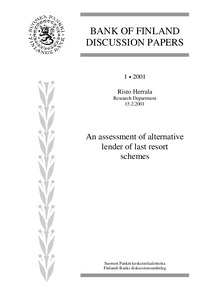An assessment of alternative lender of last resort schemes
Herrala, Risto (15.02.2001)
Numero
1/2001Julkaisija
Suomen Pankki
2001
Julkaisun pysyvä osoite on
https://urn.fi/URN:NBN:fi:bof-20140807133Tiivistelmä
We sketch a theoretical framework for comparing the properties of funded LOLR schemes.We construct an idealized lender of last resort and investigate how it formulates policy under alternative public and private governance structures.The alternatives are a (first-best) social utility maximizer that can dictate participation, and three voluntary schemes: a public lender of last resort, a mutual clearing house that formulates policy by voting, and a profit maximizing private LOLR scheme.We compare the policies formulated by these institutions from the viewpoint of social desirability.Our model targets the debate on free banking, in particular the issue of whether private institutions would fare well as lenders of last resort.In our model, the first-best LOLR scheme always covers the whole banking sector and offers full insurance to the participants.We find that voluntary schemes succeed relatively well as lenders of last resort in situations where recipients of LOLR assistance can repay LOLR loans with interest.In this case, the LOLR can use interest rate policy to make the scheme attractive to banks of every quality and thus create incentives for comprehensive entry.In private schemes, policy tends to be distorted if the private scheme is the only possible scheme.However, competitive forces lead private institutions to approach the first-best outcome, which is the only contestable outcome.The end result changes when we investigate a situation in which banks' ability to repay LOLR loans is limited. When lending is associated with losses for the LOLR, good quality banks will tend to stay out of the LOLR scheme and participation in voluntary schemes will always fall short of the first-best outcome. A compulsory scheme (such as a central bank that can impose a reserve requirement on banks) has an advantage over voluntary schemes.Key words: liquidity, lender of last resort, banking, central banking, governance
